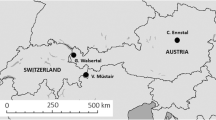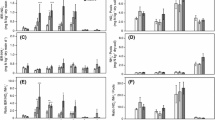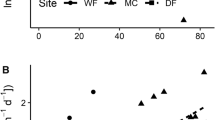Abstract
Invasions by exotic forbs are changing large areas of North American grasslands, but their biogeochemical impacts are not well characterized. Additionally, although many invasive plants may alter biogeochemistry, an invasive species’ effects have rarely been evaluated across physically diverse sites. We sampled nine sites containing the perennial Eurasian forb Centaurea maculosa to determine if this invasive species alters soil C and N pools in native grasslands in Montana, USA. We sampled surface soil in adjacent microsites with C. maculosa and native grasses and analyzed soil C and N pools with slow to rapid turnover. None of the pools evaluated in the laboratory showed significant differences between C. maculosa and grass microsites when analyzed across all sites. Some differences were found at individual sites, but they were infrequent and inconsistent: Four sites had no differences, four had differences in one or two pools with intermediate (particulate organic matter C or N) or rapid turnover rates (potentially mineralizable N), and just one site had differences encompassing pools with rapid, intermediate, and slow (total C and N, silt-and-clay-associated N) turnover rates. Where they differed, pools were usually smaller under C. maculosa plants than under native grasses, but the opposite was found at one site. In situ N availability, estimated using ion exchange resins, was significantly lower under C. maculosa than under grasses at one of three sites sampled. Results indicate that C. maculosa may sometimes reduce soil C and N pools, including those related to N availability, but they argue against generalizing about the impacts of C. maculosa in grasslands.


Similar content being viewed by others
References
InstitutionalAuthorNameAPHA (1998) Standard methods for the examination of water and wastewater. 20th ed American Public Health Association Washington, DC
HP Bais TS Walker FR Stermitz RA Hufbauer JM Vivanco (2002) ArticleTitleEnantiomeric-dependent phytotoxic and antimicrobial activity of (±)-catechin. A rhizosecreted racemic mixture from spotted knapweed Plant Physiol 128 1173–9 Occurrence Handle10.1104/pp.011019 Occurrence Handle1:CAS:528:DC%2BD38XivFyltbs%3D Occurrence Handle11950966
F Berendse (1998) ArticleTitleEffects of dominant plant species on soils during succession in nutrient-poor ecosystems Biogeochemistry 42 73–88 Occurrence Handle10.1023/A:1005935823525
IC Burke WK Laurenroth MA Vinton PB Hook RH Kelly HE Epstein MR Aguiar MD Robles MO Aguilera KL Murphy (1998) ArticleTitlePlant-soil interactions in temperate grasslands Biogeochemistry 42 121–43 Occurrence Handle10.1023/A:1005987807596
JM DiTomaso (2000) ArticleTitleInvasive weeds in rangelands: species, impacts, and management Weed Sci 48 255–65 Occurrence Handle1:CAS:528:DC%2BD3cXjsFeqsL4%3D
JG Ehrenfeld P Kourtev W Huang (2001) ArticleTitleChanges in soil functions following invasions of exotic understory plants in deciduous forests Ecol Applic 11 1287–300
RD Evans R Rimer L Sperry J Belnap (2001) ArticleTitleExotic plant invasion alters nitrogen dynamics in an arid grassland Ecol Applic 11 1301–10
HD Fraleigh Jr D Peters KG Beck WJ Parton (2000) ArticleTitleInvestigating the impact of Russian knapweed invasion on nitrogen cycling in grasslands using computer modeling Proc Western Soci Weed Sci 53 44–5
DR Gordon (1998) ArticleTitleEffects of invasive, non-indigenous plant species on ecosystem processes: lessons from Florida Ecol Applic 8 975–89
PB Hook IC Burke (2000) ArticleTitleBiogeochemistry in a shortgrass landscape: control by topography, soil texture, and microclimate Ecology 81 2686–703
PB Hook IC Burke WK Lauenroth (1991) ArticleTitleHeterogeneity of soil and plant N and C associated with individual plants and openings in North American shortgrass steppe Plant Soil 138 247–56 Occurrence Handle1:CAS:528:DyaK38XktVentQ%3D%3D
DU Hooper PM Vitousek (1998) ArticleTitleEffects of plant composition and diversity on nutrient cycling Ecol Monogr 68 121–49
. Inderjit KMM Dakshini (1994) ArticleTitleAllelopathic effect of Pluchea lanceolata (Asteraceae) on characteristics of four soils and tomato and mustard growth Am J Bot 81 799–804
RG Kelsey LJ Locken (1987) ArticleTitlePhytotoxic properties of cnicin, a sesquiterpene lactone from Centaurea maculosa (spotted knapweed) J Chem Ecol 13 19–33 Occurrence Handle1:CAS:528:DyaL2sXhtlGhu7o%3D
JR Lacey CB Marlow JR Lane (1989) ArticleTitleInfluence of spotted knapweed (Centaurea maculosa) on surface runoff and sediment yield Weed Technol 3 627–31
MC Mack CM D’Antonio RE Ley (2001) ArticleTitleAlteration of ecosystem nitrogen dynamics by exotic plants: a case study of C4 grasses in Hawaii Ecol Applic 11 1323–35
MJ McKone CM Lively (1993) ArticleTitleStatistical analysis of experiments conducted at multiple sites Oikos 67 184–6
DC Montgomery (1984) Design and analysis of experiments. 2nd ed John Wiley & Sons New York
BE Olson RG Kelsey (1997) ArticleTitleEffect of Centaurea maculosa on sheep rumen microbial activity and mass in vitro J Chem Ecol 23 1131–44 Occurrence Handle10.1023/B:JOEC.0000006391.88098.12 Occurrence Handle1:CAS:528:DyaK2sXjslGjtbw%3D
BE Olson RT Wallander (2002) ArticleTitleEffects of invasive forb litter on seed germination, and seedling growth and survival Basic Appl Ecol 3 309–17
WM Ridenour RM Callaway (2001) ArticleTitleThe relative importance of allelopathy in interference: the effects of an invasive weed on a native bunchgrass Oecologia 126 444–50 Occurrence Handle10.1007/s004420000533
S Saggar PD McIntosh CB Hedley H Knicker (1999) ArticleTitleChanges in soil microbial biomass, metabolic quotient, and organic matter turnover under Hieracium (H. pilosella L.) Biol Fertil Soils 30 232–8 Occurrence Handle10.1007/s003740050613 Occurrence Handle1:CAS:528:DyaK1MXns1Slurk%3D
NA Scott (1998) ArticleTitleSoil aggregation and organic matter mineralization in forests and grasslands: plant species effects Soil Sci Soc Am J 62 1081–9 Occurrence Handle1:CAS:528:DyaK1cXls1Gjsr0%3D
NA Scott S Saggar PD McIntosh (2001) ArticleTitleBiogeochemical impact of Hieracium invasion in New Zealand’s grazed tussock grasslands: sustainability implications Ecol Applic 11 1311–22
RL Sheley JS Jacobs ML Carpinelli (1999) Spotted knapweed RL Sheley JK Petroff (Eds) Biology and management of noxious rangeland weeds Oregon State University Press Corvallis, OR 350–61
TD Sperber JM Wraith BE. 2003 Olson (.) ArticleTitleSoil physical properties associated with spotted knapweed and native grasses are similar Plant Soil (in press) . .–.
MA Vinton IC Burke (1995) ArticleTitleInteractions between individual plant species and soil nutrient status in shortgrass steppe Ecology 76 1116–33
MA Vinton IC Burke (1997) ArticleTitleContingent effects of plant species on soils along a regional moisture gradient in the Great Plains Oecologia 110 393–402 Occurrence Handle10.1007/s004420050174
PM Vitousek LR Walker (1989) ArticleTitleBiological invasion by Myrica faya in Hawaii: plant demography, nitrogen fixation, ecosystem effects Ecol Monogr 59 247–65
DA Wedin J Pastor (1993) ArticleTitleNitrogen mineralization dynamics in grass monocultures Oecologia 96 186–92
DA Wedin D Tilman (1990) ArticleTitleSpecies effects on nitrogen cycling: a test with perennial grasses Oecologia 84 433–41
Acknowledgments
We thank James J. Conner, Rosie Wallander, and Tamara Sperber for assisting with locating sites and conducting field and laboratory work. This work was supported by the Montana Agricultural Experiment Station and the NRI Competitive Grants Program/USDA (Award No. 99-35315-7794). Approved as MAES contribution No. J-2002-27.
Author information
Authors and Affiliations
Corresponding author
Rights and permissions
About this article
Cite this article
Hook, P., Olson, B. & Wraith, J. Effects of the Invasive Forb Centaurea maculosa on grassland Carbon and Nitrogen Pools in Montana, USA. Ecosystems 7, 686–694 (2004). https://doi.org/10.1007/s10021-004-0006-1
Received:
Accepted:
Published:
Issue Date:
DOI: https://doi.org/10.1007/s10021-004-0006-1




